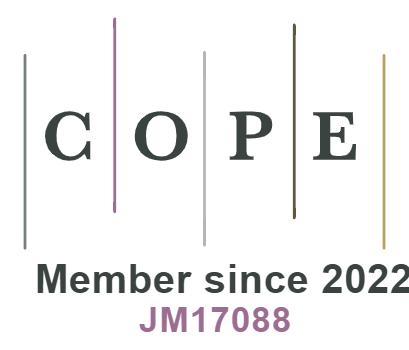Event-triggered model predictive tracking control of aero-engine with varying prediction horizon
Abstract
Aero-engine is a complex thermal-mechanical system with strong nonlinearity, uncertainty, and time variation. Thus, it is crucial to design an effective controller for such a complex system to obtain the desired performances of the aero-engine. In recent years, model predictive control (MPC) has shown great potential in dealing with control problems with complex constraints of multi-variable systems, which has been applied to aero-engine control, achieving good results. Furthermore, the MPC strategy using an event-driven mechanism is good at balancing system resources and ensuring system control performances. In this paper, the problem of event-triggered MPC for aero-engine systems with bounded disturbances is studied. Firstly, an event-triggered strategy with a dynamic forced-trigger mechanism is proposed. Then, an MPC algorithm based on an event-triggered mechanism is designed. Finally, an application to the JT9D aero-engine model provided by T-MATS verifies the effectiveness of the designed algorithm. It is shown that the calculation load is significantly reduced, which proves the superiority of this method.
Keywords
1. INTRODUCTION
An aero-engine is a complex thermal-mechanical system that is the heart of an aircraft and determines its stability, safety, and reliability. An effective controller of an aero-engine is the key to guaranteeing the normal operation of such a complex thermal-mechanical system and the safety of an aircraft. However, designing a controller for an aero-engine remains a challenge due to its strong nonlinearity and time-varying characteristics. Recently, a lot of works on aero-engine control have been carried out, for instance: [1–6]. Among them, model predictive control (MPC) has gained significant attention due to its remarkable control effectiveness.
MPC has been favored in the field of industrial process control since it was first proposed in the 1970s [7]. With its great potential in dealing with control problems with complex constraints of multi-variable systems, some interesting results about MPC have been presented [8–12]. In the meantime, due to the fact that MPC is a method based on time rolling optimization, the long prediction time domain and the uncertainty of a system make the online optimization much more complicated. A system frequently performs the rolling solution of complex optimization control problems, resulting in a heavy burden on the online calculation of a controller, which has become the main difficulty hindering the practical application of predictive control methods. Currently, reducing the computational load of online calculations is a key focus in enhancing the efficiency of MPC.
It is worth mentioning that in the 1990s, work [13] first proposed a control scheme based on an event-driven mechanism. The so-called event-triggered control means that a designer considers detailed system behavior when designing a controller and uses it as the signal to trigger control actions. When corresponding event-driven conditions are satisfied, a system is driven to carry out the next operation. In this way, system resources can be saved without affecting control performances. Hence, the combination of an event-triggered strategy and MPC named event-triggered MPC (EMPC) has the potential to reduce the frequency of solving optimization problems and save system resources without affecting control performances. Based on the above advantages, great attention has been paid to studying event-triggered strategies and various interesting results for EMPC are reported; for example, work [14] has studied an EMPC strategy for continuous-time nonlinear systems, and an event-triggered condition has been designed by measuring errors between the tracking outputs and the reference; work [15] has proposed a new aperiodic formulation of MPC for nonlinear systems and some new event-triggered conditions has been provided in which the optimal cost is not used as the Lyapunov function candidate; work [16] has proposed a robust EMPC scheme for linear time-invariant discrete-time systems by designing an event condition based on a given probability distribution of disturbances acting on the system; work [17] has proposed an adaptive threshold-based event-triggered mechanism that dynamically determines the triggering time based on real-time performance of tracking; The article [18] has designed a local controller based on the principle of event triggering, utilizing asynchronous impact control to develop a predictive controller. However, one may notice that the aero-engine model was always rarely mentioned as a complex control model, and it still lacks an effective EMPC algorithm to be applied to the control of aero-engines, which is still a challenging open issue [19].
Motivated by the above discussions, in this paper, we shall study the problem of MPC for aero-engine by designing a novel event-triggering strategy with the aim of reducing computational load while stabilizing the closed-loop system. The main contributions of this work are as follows:
1. An EMPC algorithm for tracking control of aero-engines is designed, which can reduce the computation load compared to the traditional MPC method.
2. A dynamic force-trigger mechanism is proposed in the designed EMPC algorithm, which provides a more flexible control strategy on the premise of ensuring system control performances.
The remainder of the paper is organized as follows. In Section Ⅱ, the EMPC algorithm is designed in which two different trigger strategies are proposed. An application of tracking control of a JT9D aero-engine is studied in Section Ⅲ to show the effectiveness of the designed EMPC algorithm. Finally, the paper is concluded in Section Ⅳ.
2. EMPC ALGORITHM DESIGN
In this section, we show the design of the EMPC algorithm, in which the two different trigger strategies are presented.
2.1. Problem formulation
Consider an aero-engine model that is given in the following form:
where
where
where
Then, we consider a tracking problem that can be formulated as the following optimization problem:
where
According to the discrete system (3), the prediction of the system can be derived:
where
Applying the system (5) to the cost function (4), one obtains that
Let
which can be further transformed as the following quadratic programming:
Note that the matrices
By applying some traditional optimal methods, such quadratic programming is easy to solve. More details can be found in [21, 22]. However, we point out that when utilizing the traditional MPC method, the optimization problem needs to be solved at each sampling time, which leads to more computing load. Thus, in the following, we shall focus on the design of the event-trigger mechanism to reduce the frequency of solving the optimization problem.
2.2. Event-Trigger Mechanism Design for MPC
The main idea of the event-triggered control is to design a threshold to check whether the control strategy should be applied or the sampled information should be updated. In EMPC, the threshold is used to determine whether the optimization problem should be solved to obtain a new control input sequence.
Consider the event
where
There is no doubt that applying such an event-trigger mechanism can reduce the frequency of solving the optimization problem while maintaining the control effect of MPC, mostly since the control input is all based on the optimized control input sequence. However, during the transient state process, the control input may not change frequently; for example, the input reaches its upper bound and maintains its maximum input value to obtain a maximum acceleration of the aero-engine. In addition, after the last value of the optimized control input sequence was updated, if the event is still not triggered at the next sampling instant, then it implies that the error between the tracking output and the reference remains in a reasonable region. Hence, the optimization problem may not necessarily be solved to refresh the control input. Here, we give another way to determine the value of the control input:
Repeat to upload the optimized control input sequence values to the controller one by one if the event is not triggered until the last value of the sequence is uploaded. If the event is still not triggered at the next sampling instant
where
Up to now, the EMPC strategy has been designed. The algorithm is presented in Algorithm 1.
Algorithm 1 Pseudo code of EMPC: Set the prediction horizon 1: 2: if 3: solve the optimization problem to obtain the control input sequence 4: upload 5: 6: 7: else 8: if 9: solve the optimization problem to obtain the control input sequence 10: upload 11: 12: 13: else 14: if 15: upload 16: 17: 18: else 19: upload 20: 21: 22: end if 23: end if 24: end if 25: go to step 2 until the terminal condition is satisfied.
In the following, we shall use a dual spool high bypass engine JT9D provided in T-MATS [23] to verify the effectiveness of the designed EMPC algorithm.
3. APPLICATION
The objective is to control the speed of the low-pressure turbine
Let us first establish a state-space model (1), where
The traditional MPC is first applied. The simulation step size
Figure 3. Simulation results for EMPC method with (8). EMPC: event-triggered model predictive control.
The main idea is to enlarge the force-trigger interval if the reference speed increases with a certain acceleration to reduce the computation load, but if the reference switches into a steady state or a small transient state, shorten the force-trigger interval to reduce the possible overshot caused by the system inertia. Then, the simulation results are shown in Figure 4. To save space, only the tracking result and the tracking error are illustrated (see Figure 4 (a) and (b), respectively). The simulations for
Figure 4. Simulation results for EMPC method with (9). EMPC: event-triggered model predictive control.
To summarize, the designed EMPC algorithm could reduce the computation load than the traditional MPC method. In addition, the proposed dynamic force-trigger mechanism can provide a more flexible control strategy on the premise of ensuring the control performance.
4. CONCLUSION
In this paper, an EMPC mechanism is proposed for aero-engine tracking, in which a dynamic forced trigger interval is designed. The tracking effect of the control method is basically guaranteed, and the frequency of solving the optimization problem is greatly reduced. This implies that the computer resources are saved. The relevant simulation experiments are carried out on the JT9D model provided by T-MATS, effectively demonstrating the theoretical results and computational efficiency of EMPC.
DECLARATIONS
Acknowledgments
The authors would like to thank the reviewers for their thoughtful comments and efforts towards improving our manuscript.
Authors' contributions
Conceptualization: Peng Y
Experiment and analyze data: Peng Y, Li P, Xu N
Manuscript drafting: Peng Y, Li Peng
Manuscript edition and review: Peng Y, Li P, Zhao X
Availability of data and materials
Not applicable.
Financial support and sponsorship
This work is supported by the National Natural Science Foundation of China (62203064), the National Major Science and Technology Project (J2019-V-0010-0105), and the Fundamental Research Funds for the Central Universities (DUT22ZD402).
Conflicts of interest
All authors declared that there are no conflicts of interest.
Ethical approval and consent to participate
Not applicable.
Consent for publication
Not applicable.
Copyright
© The Author(s) 2023.
REFERENCES
1. Zhou B, Xie S, Wang F, Hui J. Multi-step predictive compensated intelligent control for aero-engine wireless networked system with random scheduling. J Franklin I 2020;69:6154-74.
2. Wang Y, Zheng Q, Xu Z, Zhang H. A novel control method for turboshaft engine with variable rotor speed based on the Ngdot estimator through LQG/LTR and rotor predicted torque feedforward. Chinese J Aeronaut 2020;33:1867-76.
3. Cai J, Hu W, Cai K. Accuracy analysis of a single-fault Markov model for FADEC system. J Syst Eng Electron 2019;30:1044-52.
4. Xiao L. Aeroengine multivariable nonlinear tracking control based on uncertainty and disturbance estimator. J Eng Gas Turb Power 2014;136:121601.
5. Du X, Richter H, Guo Y. Multivariable Sliding-Mode Strategy with Output Constraints for Aeroengine Propulsion Control. J Guid Control Dyn 2016;39:1631-42.
6. Liu T, Du X, Sun X, Richter H, Zhu F. Robust tracking control of aero-engine rotor speed based on switched LPV model. Aerosp Sci Technol 2019;91:382-90.
7. Richalet J, Rault A, Testud JL, Papon J. Model predictive heuristic control-Applications to an industrial process. Automatica 1978;14:413-428.
8. Gao J, Gong C, Li W, Liu J. Novel Compensation Strategy for Calculation Delay of Finite Control Set Model Predictive Current Control in PMSM. IEEE T Ind Electron 2020;67:5816-9.
9. Zhang YQ, Yin Z, Li W, Liu J, Zhang YP. Adaptive Sliding-Mode-Based Speed Control in Finite Control Set Model Predictive Torque Control for Induction Motors. IEEE T Ind Electron 2021;36:8076-87.
10. Zheng Q, Wang Y, Sun F, Zhang H. Aero-engine direct thrust control with nonlinear model predictive control based on linearized deep neural network predictor. Proc I Mech Eng 2020;234:8076-87.
11. Song S, Hei R, Ma R, Liu W. Model Predictive Control of Switched Reluctance Starter/Generator With Torque Sharing and Compensation. IEEE T Transp Electr 2020;6:1519-27.
12. Wang Z, Du X, Sun X. The Design of Predictive Controller for Aero-engine Based on Self-tuning Model. vol. 6. ASME Turbo Expo: Turbomachinery Technical Conference and Exposition; 2019;6.
13. Xi N, Tarn TJ. Intelligent planning and control for multirobot coordination: An event-based approach. IEEE Transactions on Robotics and Automation 1996;12:439-52.
14. Li H, Shi Y. Event-triggered robust model predictive control of continuous-time nonlinear systems. Automatica 2014;50:1507-13.
15. Hashimoto K, Adachi S, Dimarogonas DV. Event-triggered intermittent sampling for nonlinear model predictive control. Automatica 2017;81:148-55.
16. Brunner FD, Heemels WPMH, Akkgower F. Robust Event-Triggered MPC With Guaranteed Asymptotic Bound and Average Sampling Rate. IEEE T Automat Contr 2017;62:5694-5709.
17. Li P, Zhao X, Gou L, Qin H. Event-Triggered Model Predictive Control for Aero-Engine Transient-State Tracking Problems. J Aerosp Inform Syst 2023;20:5, 229-39.
18. Sanchez J C, Louembet C, Gavilan F, Vazquez R. An Event-Triggered Predictive Controller for Spacecraft Rendezvous Hovering Phases. IFAC-PapersOnLine 2019;52:97-102.
19. Li P, Zhao X, Qin H, Wang Z, Niu B. Dynamic Event-Triggered Finite-Time H∞ Tracking Control of Switched LPV Aero-Engine Models. IEEE T Circuits-Ⅱ 2022;69:1114-8.
20. Hu Y, Bian Y, Gou L, Fan D. LPV/PI Control for Nonlinear Aeroengine System Based on Guardian Maps Theory. IEEE Access 2019;7:125854-67.
21. Yu B, Li Z, Ke H, Zhang T. Wide-range model predictive control for aero-engine transient state. Chinese J Aeronaut 2022;35:246-60.
22. Du X, Sun X, Wang Z, Dai A. A scheduling scheme of linear model predictive controllers for turbofan engines. IEEE Access 2017;5:24533-41.
23. Jeffryes. nasa/T-MATS. Available from: https://github.com/nasa/T-MATS. [Last accessed on 21 Oct 2023].
Cite This Article
How to Cite
Download Citation
Export Citation File:
Type of Import
Tips on Downloading Citation
Citation Manager File Format
Type of Import
Direct Import: When the Direct Import option is selected (the default state), a dialogue box will give you the option to Save or Open the downloaded citation data. Choosing Open will either launch your citation manager or give you a choice of applications with which to use the metadata. The Save option saves the file locally for later use.
Indirect Import: When the Indirect Import option is selected, the metadata is displayed and may be copied and pasted as needed.






















Comments
Comments must be written in English. Spam, offensive content, impersonation, and private information will not be permitted. If any comment is reported and identified as inappropriate content by OAE staff, the comment will be removed without notice. If you have any queries or need any help, please contact us at [email protected].